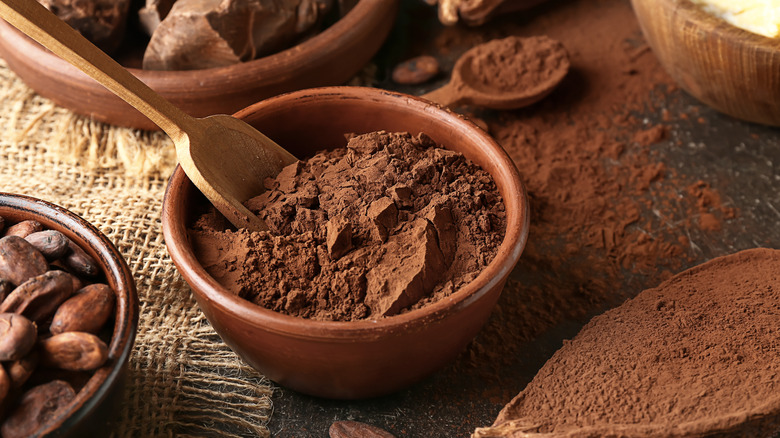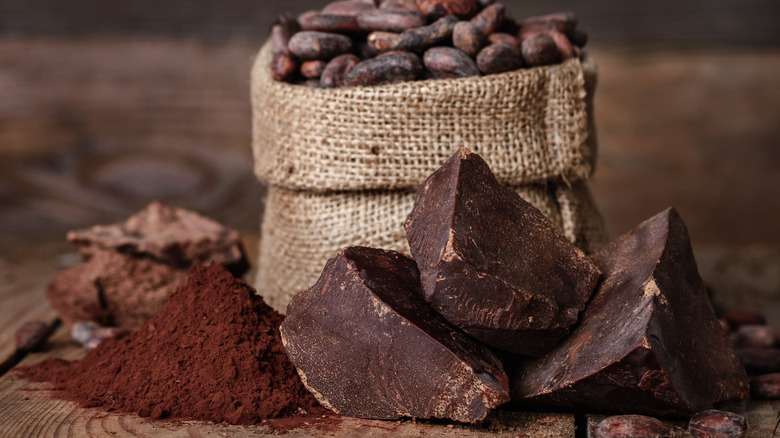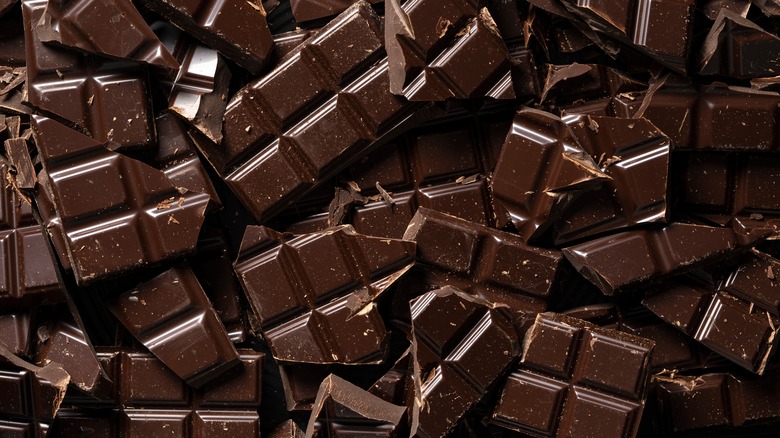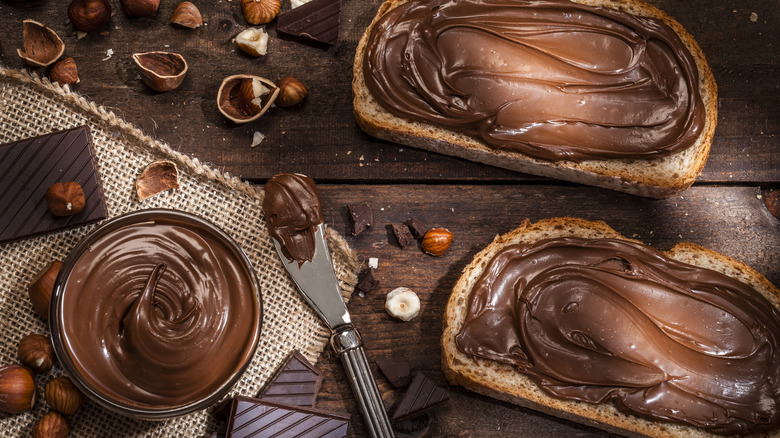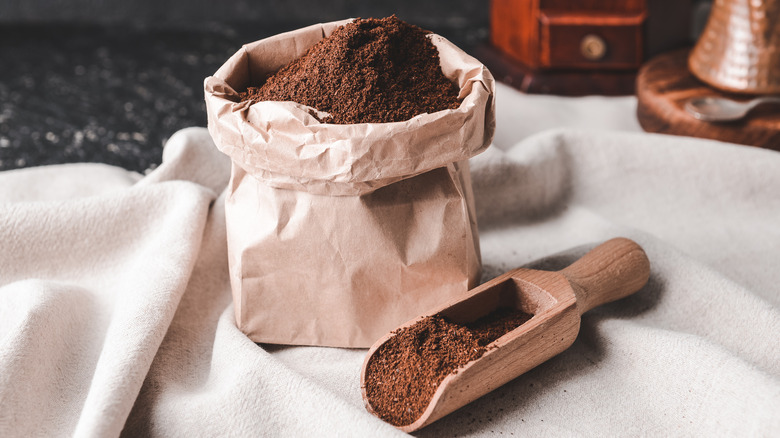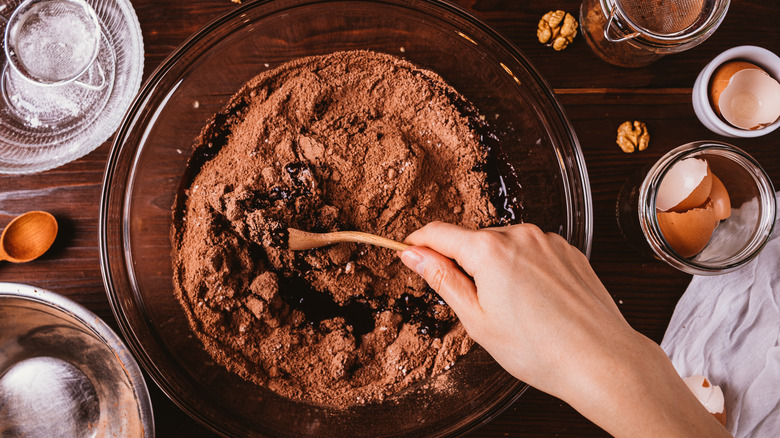The Easiest Substitutes For Cocoa Powder In A Pinch
Cocoa powder is one of those baking staples that is often taken for granted but whose presence is sorely missed when you happen to run out of it. Cocoa powder is made from the solids that are left behind after cacao seeds have been roasted, fermented, and pressed to get rid of most of the cocoa butter, giving the resulting powder a more concentrated flavor of chocolate. Without the fat and added sugar, even a tiny spoonful of unsweetened cocoa powder can bring buckets of bold and bitter tasting notes that aren't always easy to find elsewhere.
Like most things in the kitchen, however, cocoa powder can be substituted in a pinch — though it will help to know what it is that the cocoa powder is doing in your recipe besides adding chocolate flavor. For example, there are several types of cocoa powder, including natural and Dutch-process. Natural cocoa powder has more bitterness and a higher level of acidity that can trigger the leavening agent aka baking soda in your bakes to help them rise.
While its deep flavor may be substituted, replacing natural cocoa powder without accounting for the missing acid to activate the baking soda could prove to be disastrous. On the flip side, Dutch-process cocoa powder is less intense and acidic, but it does have a darker color than its natural counterpart. Not taking into consideration its deep rich hue could very well leave your bakes and drinks looking more pale than they should.
Baking chocolate is a great cocoa powder substitute
One of the best substitutes for cocoa powder is baking chocolate, also known as unsweetened chocolate. This is because baking chocolate is essentially just cocoa liquor with equal amounts of cocoa solids and cocoa butter in it, which when extracted gives rise to cocoa powder. As such, baking chocolate has a strong, bitter intensity that makes it an excellent substitute for cocoa powder in recipes where you want a deep flavor of chocolate. In cases where you only want a subtle hint of chocolate from your cocoa powder, however, baking chocolate isn't the best swap.
Baking chocolate is best used when it's melted first — after which four tablespoons of the thick liquid can be used to substitute every three tablespoons of cocoa powder in your recipe. That said, baking chocolate does tend to be very bitter, so you might want to consider whisking in a bit of sugar before you add it to your batters. Unlike cocoa powder, baking chocolate also has cocoa butter in it, so it's a good idea to reduce the quantity of other fats in your recipe. While the extra fat and sugar may affect the texture of your bakes, baking chocolate will tick all the boxes in the flavor and aroma department that cocoa powder would.
Dark chocolate is another worthy substitute
Baking chocolate aside, another effective substitute for cocoa powder is dark chocolate, thanks to its high cocoa percentage, which gives it the same bitter intensity as cocoa powder. As a bonus, dark chocolate will also give your foods and drinks that rich brown color that some types of cocoa powder (like Dutch) would. Do note that even the darkest of chocolates (except for maybe 100% dark) have some sugar included, so be sure to compensate accordingly.
When swapping cocoa powder with dark chocolate, pick a bar with the highest percentage of cocoa that's available to you. The higher the cocoa percentage, the more cocoa solids the chocolate will have, and the smaller the amount of sugar, giving it a much closer flavor to that of cocoa powder. Once you have your chocolate, melt it just as you would baking chocolate, and use four tablespoons of the liquid for every three tablespoons of cocoa powder.
Use the chocolate spreads sitting in your pantry
Who doesn't have a jar of Nutella or some type of chocolate spread sitting in their pantry at all times? If you do too, huzzah! These creamy pastes will come to the rescue of all your cocoa powder troubles at but a moment's notice — especially if it's the rich and decadent flavor of chocolate that you'd like to replace in your batters and frostings.
Though easy to use in a pinch, there are a few things to bear in mind when using a chocolate spread in place of cocoa powder. Spreads like Nutella, though packed with chocolatey goodness, can be extremely high in sugar and things like palm oil. This is why you will need to reduce the quantity of any sugar that you add on top, as well as any fats like oil and butter that the recipe calls for. When you can, stick to a chocolate spread that has cocoa powder high up on its ingredient list — such spreads will make for the best substitutes.
Additionally, some chocolate spreads, such as Nutella, have additional flavors from things like nuts in them. So, if you're whisking together something that requires a pure, unadulterated flavor of chocolate, spreads may not be the most suitable option. If you don't mind a little hazelnut taste, you can go ahead and use two or three times the amount of chocolate spread to replace cocoa powder.
Espresso powder is a flavor boost
It only seems logical that the substitute for cocoa powder would be other equally chocolatey ingredients, so the fact that instant espresso powder and cocoa powder are excellent replacements for each other may come as a wonderful surprise. Cocoa powder and espresso powder have a lot in common: They both have a bitter flavor, they share an acidic nature, and both will impart a rich, dark hue to whatever it is that they are added to.
If you need a swap for cocoa powder in a recipe where chocolate isn't the shining ingredient or in a savory dish that only has a hint of cocoa, espresso powder is an easy alternative. As a bonus, if your recipe already has other sources of chocolate in it — say melted chocolate in fudgy cakes, brownies, and rich ganaches — a dash of espresso powder will only boost the chocolate flavor. The one thing to be cautious about is that espresso powder can quickly overpower other ingredients so it's best to use it in very small quantities — roughly half or even a quarter of the quantity as cocoa powder. Also, note its caffeine content makes it an unwise choice if children will be eating the dish.
Put powdered chocolate mixes to work
If you're halfway through a recipe with no other cocoa powder substitute to spare, it's a good idea to consider other powders in your kitchen that taste like chocolate — think drinking chocolate powders, hot cocoa, and hot chocolate mixes (especially if it's a drink that you're making), or even chocolate-flavored protein powders that can give your recipes the additional boost of protein as well. These powders already have some amount of cocoa powder in them — albeit with additional ingredients such as sugar, milk powder, flavorings, and in the case of protein powders, well, protein.
Because of their powdered forms, these substitutes can be used just as you would cocoa powder, except you'd need to increase their quantities to make up for the lost chocolate flavor that may be diluted with other ingredients. Use double the amount of hot cocoa, hot chocolate, drinking chocolate, or protein powder mixes than you would cocoa powder, and pick mixes with higher percentages of cocoa where you can — these will resemble the flavor of cocoa powder the closest. That said, you will also be adding extra sugar, milk powder, and flavors to your recipe, so it's always best to start slow and taste as you add more.

